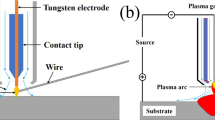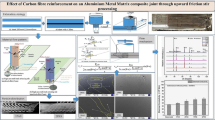Abstract
The clinched process of heterogeneous materials is increasingly used in automobile, aerospace, and household appliances manufacturing. To investigate the forming quality of clinched joint for dissimilar sheet metal, the clinching experiments are carried out, and the cross-section morphology of clinched joints is observed. The finite element model for forming steel-aluminum clinched joint is established. The influence of process parameters (forming process parameters, geometry parameters, and concave die structural parameters) on the forming quality of steel-aluminum clinched joint is analyzed. The evaluation of the joint after forming includes the critical dimension, deformation, and neck-lock ratio. Then, the strength of the joint is measured by the tensile shear test. The changing law of strength and the neck-lock ratio is analyzed. The design strategy of different process parameters is proposed. The results show that the forming process of the joint is well predicted by numerical simulation, and the joint quality is good. The neck lock ratio of the joint with the highest tensile and shear strength is close to 1 when the forming force is 40 kN. The tensile strength and shear strength of the joint are increased by 125% and 62.35%. The design strategy is verified by experiments. The shear strength of the joint is increased by 16.49%.




















Similar content being viewed by others
Availability of data and materials
The data during the current study are available from the corresponding author on reasonable request.
References
Sachin J, Sudhir K, Sanjeev K (2021) Characterization and optimization of flat friction stir spot welding of triple sheet dissimilar aluminium alloy joints. SILICON 1:1–16
Ang HQ (2021) An overview of self-piercing riveting process with focus on joint failures, corrosion issues and optimisation techniques. Chin J Mech Eng 34:1–25
Abe Y, Mori K, Kato T (2012) Joining of high strength steel and aluminium alloy sheets by mechanical clinching with dies for control of metal flow. J Mater Process Tech 212:884–889
Abe Y, Kato T, Mori K, Nishino S (2014) Mechanical clinching of ultra-high strength steel sheets and strength of joints. J Mater Process Tech 214: 2112–2118. Yohei Abe, Toru Kato, Ken-ichiro Mori, Shoma Nishino
Atia MKS, Jain MK (2017) Die-less clinching process and joint strength of AA7075 aluminum joints. Thin-Walled Struct 120:421–431
Mucha J, Witkowski W (2014) The clinching joints strength analysis in the aspects of changes in the forming technology and load conditions. Thin-Walled Struct 82:55–66
Chen C, Zhao SD, Han XL, Cui MC, Fan SQ (2017) Investigation of the height-reducing method for clinched joint with AL5052 and AL6061. Int J Adv Manuf Technol 89:2269–2276
Chen C, Han XL, Zhao SD, Xu F, Zhao XZ, Ishida T (2017) Comparative study on two compressing methods of clinched joints with dissimilar aluminum alloy sheets. Int J Adv Manuf Technol 93:1929–1937
Chen C, Zhao SD, Cui MC, Han XL, Fan SQ, Ishida T (2016) An experimental study on the compressing process for joining Al6061 sheets. Thin-Walled Struct 108:56–63
Chen C, Fan SQ, Han XL, Zhao SD, Cui MC, Ishida T (2017) Experimental study on the height-reduced joints to increase the cross-tensile strength. Int J Adv Manuf Technol 91:2655–2662
Chen C, Zhao SD, Han XL, Cui MC, Zhao XZ, Ishida T (2017) Experimental investigation of the mechanical reshaping process for joining aluminum alloy sheets with different thicknesses[J]. J Manuf Process 26:105–112
Chen C, Zhao SD, Han XL, Cui MC, Fan SQ (2016) Investigation of mechanical behavior of the reshaped joints realized with different reshaping forces. Thin-Walled Struct 107:266–273
Shi C, Yi RX, Chen C, Peng H, Ran XK, Zhao SD (2020) Forming mechanism of the repairing process on clinched joint. J Manuf Process 50:329–335
Chen C, Ran XK, Peng H, Zhang HY, Yi RX, Han XL (2020) Research on the mechanical properties of repaired clinched joints with different forces. Thin-Walled Struct 152:106752
Huang ZQ, Yanagimoto J (2015) Dissimilar joining of aluminum alloy and stainless steel thin sheets by thermally assisted plastic deformation. J Mater Process Tech 225:393–404
Lambiase F, Ko DC (2016) Feasibility of mechanical clinching for joining aluminum AA6082-T6 and Carbon Fiber Reinforced Polymer sheets. Mater Des 107:341–352
Lambiase F (2015) Joinability of different thermoplastic polymers with aluminium AA6082 sheets by mechanical clinching. Int J Adv Manuf Technol 80:1995–2006
Babalo V, Fazli A, Soltanpour M (2021) Experimental study of the mechanical performance of the new high-speed mechanical clinching. Int J Adv Manuf Technol 4:218–236
Ge YL, Xia Y (2020) Mechanical characterization of a steel-aluminum clinched joint under impact loading. Thin-Walled Struct 151:106759
He XC, Liu FL, Xing BY, Yang HY, Wang YQ, Gu FS, Ball A (2014) Numerical and experimental investigations of extensible die clinching. Int J Adv Manuf Technol 74:1229–1236
Chen C, Zhao SD, Cui MC, Han XL, Zhao XZ, Ishida T (2017) Effects of geometrical parameters on the strength and energy absorption of the height-reduced joint. Int J Adv Manuf Technol 90:3533–3541
Wen T, Wang H, Yang C, Liu LT (2014) On a reshaping method of clinched joints to reduce the protrusion height. Int J Adv Manuf Technol 71:1709–1715
Chen C, Zhao SD, Cui MC, Han XL, Ben NY (2017) Numerical and experimental investigations of the reshaped joints with and without a rivet. Int J Adv Manuf Technol 88:2039–2051
Coppieters S, Cooreman S, Lava P, Sol H, Houtte PV, Debruyne D (2011) Reproducing the experimental pull-out and shear strength of clinched sheet metal connections using FEA. Int J Mater Form 4:429–440
Tenorio MB, Lajarin SF, Gipiela ML, Marcondes PVP (2019) The influence of tool geometry and process parameters on joined sheets by clinching. J Braz Soc Mech Sci Eng 41:49–55
Josip C, Antun S, Miroslav D, Ivan S (2019) FEM numerical simulations of the mechanical clinching process of HC260Y Steel. Tehnički vjesnik 26:4943–4954
Mucha J (2011) The analysis of lock forming mechanism in the clinching joint. Mater Des 32:4943–4954
Lee CJ, Lee JM, Ryu HY, Lee KH, Kim BM, Ko DC (2014) Design of hole-clinching process for joining of dissimilar materials–Al6061-T4 alloy with DP780 steel, hot-pressed 22MnB5 steel, and carbon fiber reinforced plastic. J Mater Process Tech 214:2169–2178
Wen T, Huang Q, Liu Q, Ou WX, Zhang S (2016) Joining different metallic sheets without protrusion by flat hole clinching process. Int J Adv Manuf Technol 85:217–225
Breda A, Coppieters S, Debruyne D (2017) Equivalent modelling strategy for a clinched joint using a simple calibration method. Thin-Walled Struct 113:1–12
Kaðèák L, Spiðák E, Kubík R, Mucha J (2017) Finite element calculation of clinching with rigid die of three steel sheets. Strength Mater 49:488–499
Israel M, Mauermann R, Schellnock J (2013) Thick sheet clinching-joining up to 20 mm total thickness. Adv Shipping Ocean Eng 2:1–10
Abe Y, Saito T, Nakagawa K, Mori K (2018) Rectangular shear clinching for joining of ultra-high strength steel sheets. Procedia Manuf 15:1354–1359
Sebastian W, Marion M (2021) Potential of shear-clinching technology for joining of three sheets. J Adv Join Process 3(prepublish):100043
Li QH, Wang BZ, Gao S, Xu CW, Ma FL, Han XH, Yuan B (2021) Study on flow stress model of high-strength steel and aluminum alloy in clinching. J Netshape Form Eng 13:121–126
Lee CJ, Kim JY, Lee SK, Ko DC, Kim BM (2010) Design of mechanical clinching tools for joining of aluminium alloy sheets. Mater Des 31(4) 1854–1861. https://doi.org/10.1016/j.matdes.2009.10.064
Acknowledgements
The authors express thanks to Changchun Schmidt Automation Technology Co. Ltd for providing experiments in the study.
Funding
This work was supported by the National Natural Science Foundation of China [No.51805045] and the Scientific and Technological Developing Scheme of Ji Lin Province [No.20190302100GX and No. 20200401115GX].
Author information
Authors and Affiliations
Contributions
Qihan Li: methodology, reviewing and editing, project administration. Chuanwei Xu: conceptualization, experiment, writing—original draft preparation. Song Gao: investigation, translate, resources. Fenglei Ma: simulation, review and editing. Qingming Zhao: investigation, validation. Dongwei Gu: investigation, reviewing and editing. Xiaoheng Han: reviewing and editing, supervision.
Corresponding author
Ethics declarations
Ethics approval
This paper is new. Neither the entire paper nor any part of its content has been published or has been accepted elsewhere. It is not being submitted to any other journal as well.
Consent to participate
Not applicable.
Consent for publication
Not applicable.
Conflict of interest
The authors declare no competing interests.
Additional information
Publisher's Note
Springer Nature remains neutral with regard to jurisdictional claims in published maps and institutional affiliations.
Rights and permissions
About this article
Cite this article
Li, Q., Xu, C., Gao, S. et al. Research on the forming quality of clinched joint for dissimilar sheet metal. Int J Adv Manuf Technol 119, 2945–2959 (2022). https://doi.org/10.1007/s00170-021-08602-1
Received:
Accepted:
Published:
Issue Date:
DOI: https://doi.org/10.1007/s00170-021-08602-1




